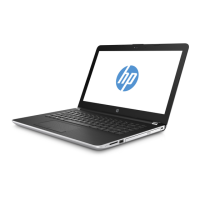
Do you have a question about the HP 14-BS0 Series and is the answer not in the manual?
| Processor | Intel Celeron N3060, Intel Pentium N3710, Intel Core i3-6006U, Intel Core i5-7200U, Intel Core i7-7500U |
|---|---|
| Storage | 500GB HDD, 1TB HDD, 128GB SSD, 256GB SSD |
| Operating System | Windows 10 Home |
| Graphics | Intel HD Graphics 400, Intel HD Graphics 520, Intel HD Graphics 620 |
| Audio | Dual speakers |
| Wireless | Bluetooth 4.2 |
| Ports | 1 x HDMI, 1 x headphone/microphone combo, 1 x RJ-45 |
| Battery | 41 Wh Li-ion |
| Display | 14-inch HD (1366 x 768) or FHD (1920 x 1080) anti-glare |
Details product names, model numbers, and configurations for different laptop models.
Lists various Intel processors supported, including generation, clock speed, and cache.
Covers panel types, resolution, surface treatment, and memory configurations for different processor types.
Lists available storage options including HDD, SSD, and eMMC configurations.
Details specifications for optical drives, cameras, audio, Ethernet, and wireless network modules.
Lists security features like Kensington lock and supported operating systems.
Details components located on the right side of the computer, including ports and lights.
Details components located on the left side of the computer, including ports and vents.
Identifies components within the display assembly, such as cameras, microphones, and antennas.
Explains the functionality of the TouchPad zone and its buttons.
Describes the function of the Caps Lock and Mute indicator lights.
Explains how to use the power button for turning on, sleep, and hibernation.
Identifies special function keys and describes the usage of action keys.
Details components visible on the bottom of the computer, including battery and vents.
Describes the information provided by service and regulatory labels on the computer.
Illustrates and lists major internal and external computer components with part numbers.
Lists and illustrates subcomponents of the display assembly, including bezels and panels.
Illustrates and lists mass storage devices like HDDs, SSDs, eMMC, and optical drives.
Illustrates and lists various internal cables and their part numbers.
Lists miscellaneous parts like AC adapters, power cords, and rubber feet kits.
Lists tools, service considerations, and precautions for handling parts and cables.
Covers precautions for handling drives, electrostatic discharge (ESD), and grounding.
Provides guidelines for safely packaging equipment and setting up a static-free workstation.
Introduces the procedures for replacing customer self-repairable parts.
Provides step-by-step instructions for removing and replacing the computer battery.
Introduces procedures for parts to be serviced by authorized providers only.
Illustrates how to remove display bezel, panel, and camera module.
Provides instructions for removing the computer's bottom cover.
Details the procedure for removing and replacing the Wireless Local Area Network (WLAN) module.
Provides step-by-step instructions for removing and replacing the memory modules.
Details the procedure for removing and replacing the computer's hard drive.
Explains the removal and replacement of the M.2 solid-state drive adapter bracket.
Provides instructions for removing and replacing the solid-state drive (SSD).
Details the procedure for removing and replacing the computer's fan.
Explains how to remove and replace the TouchPad button board.
Provides instructions for removing and replacing the heat sink assembly.
Details the procedure for removing and replacing the computer speakers.
Explains how to remove and replace the USB board.
Provides detailed instructions for removing and replacing the system board.
Details the procedure for removing and replacing the Real-Time Clock (RTC) battery.
Provides instructions for removing and replacing the entire display assembly.
Explains how to remove and replace the power connector cable.
Details the procedure for removing and replacing the power button board.
Explains the process for replacing the top cover and keyboard assembly.
Includes starting BIOS, updating BIOS, and determining the current BIOS version.
Provides a step-by-step guide for downloading BIOS update files from the HP website.
Guides on creating recovery media and system backups for data protection.
Covers various system recovery options using HP Recovery Manager and partitions.
Instructions for changing boot order and removing the HP Recovery partition.
Instructions on how to launch the HP PC Hardware Diagnostics UEFI tool.
Guides on downloading HP PC Hardware Diagnostics to a USB drive.
Lists general specifications for the computer, including dimensions, weight, and operating conditions.
Provides detailed specifications for the 35.6-cm (14.0-in) display panel.
Lists specifications for 1-TB and 500-GB hard drives, including dimensions and transfer rates.
Details specifications for M.2 solid-state drives, including capacities and transfer rates.
Lists specifications for the DVD±RW SuperMulti DL optical drive.
Outlines general requirements applicable to power cord sets in all countries.
Lists specific power cord set requirements and certifications for various countries and regions.
Provides information on proper battery disposal and HP's recycling programs.